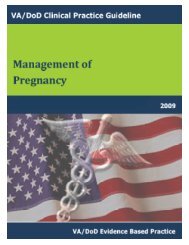DM Full Guideline (2010) - VA/DoD Clinical Practice Guidelines Home
DM Full Guideline (2010) - VA/DoD Clinical Practice Guidelines Home
DM Full Guideline (2010) - VA/DoD Clinical Practice Guidelines Home
Create successful ePaper yourself
Turn your PDF publications into a flip-book with our unique Google optimized e-Paper software.
Version 4.0<br />
<strong>VA</strong>/<strong>DoD</strong> <strong>Clinical</strong> <strong>Practice</strong> <strong>Guideline</strong><br />
for the Management of Diabetes Mellitus<br />
modest effects in non-insulin users, but may be useful in insulin users or clearly in those seeking tight control (e.g.<br />
gestational diabetes). Electronic data transfer methods may help patients manage the data better, but with uncertain<br />
therapeutic benefits.<br />
Efficacy of SMBG in Patients with Type-2 diabetes, not Requiring Insulin<br />
• Balk et al. (2007) suggested a small but clinically nonsignificant reduction in HbA 1 c with SMBG but the<br />
studies were inconclusive for patients with non insulin requiring type 2 diabetes.<br />
• Jansen (2006) found a small reduction (0.21-0.83%) in HbA 1 c in non-insulin using patients with type 2<br />
diabetes using SMBG and the reduction was larger if the patients were given regular medical feedback.<br />
• McGeoch et al. (2007) concluded that SMBG was most beneficial in patients with type 2 diabetes and<br />
HbA 1 c of greater than 8% and the patient understood what to do with the results. McGeoch suggested<br />
benefit of SMBG in persons with newly diagnosed non-insulin requiring type 2 diabetes, those undergoing<br />
initiation of, or a change in medication as well as those with gestational diabetes, hypoglycemia<br />
unawareness, or who were ill.<br />
• Poolsup et al. (2008) found that SMBG was beneficial (decrease in HbA1c of 0.27%) in patients with noninsulin<br />
requiring type 2 diabetes as long as the information was used to adjust treatment regimens. If the<br />
patient had well-controlled diabetes, SMBG was not as efficacious.<br />
• Sarol et al. (2005) concluded that patients with non insulin requiring type 2 diabetes using SMBG and<br />
integrating the results with educational advice achieved greater HbA 1 c reduction (0.39%). The<br />
recommendation for frequency of testing SMBG was 5 to 7 times per week.<br />
• Towfigh et al. (2008), in a meta-analysis of 9 RCTs of SMBG use among patients with non-insulin<br />
requiring type 2 diabetes demonstrated a clinically modest, but statistically significant decrease in HbA 1 c<br />
(0.21%) outcomes at 6 months. Results at 3 months or 12 months were not significant. Their overall<br />
conclusion was that SMBG is an intervention of modest efficacy in patients with <strong>DM</strong> not taking insulin,<br />
although their analysis of “quality studies” indicated no benefit.<br />
• Welschen et al. (2005) found that patients with non-insulin requiring type 2 diabetes using SMBG had a<br />
statistically significant but clinically small (0.39%) decrease in HbA 1 c.<br />
• Farmer et al. (2007) showed no difference in glycemic control in SMBG utilizing patients versus controls.<br />
The conclusion was that SMBG was not effective.<br />
• Simon et al. (2008) showed that SMBG with training was not cost effective.<br />
• O’Kane et al. (2008) showed that patients newly diagnosed with diabetes showed no difference in drop in<br />
HbA 1 c in SMBG versus non SMBG patients. Patients in both groups were aggressively treated and had 1.6<br />
drop in HbA 1 c in 3 months.<br />
Remote Monitoring of Blood Glucose<br />
• Farmer et al. (2005) showed that remote monitoring was feasible but not efficacious.<br />
• Balas et al. (2004) evaluated the effectiveness of computerized analysis and reporting for insulin dose and<br />
therapy adjustments in 25 studies with1286 adults and 197 children. Results suggested small, but<br />
significant improvement in diabetes outcomes, but additional educational and or technical interventions<br />
were included in several of the studies and findings did not differentiate among the impact of the various<br />
interventions.<br />
• Bergenstal et al. (2005) randomized patients to modem transfer of SMBG data or telephone transfer of the<br />
SMBG. Patients in both groups were contacted weekly. Although the modem transmission was more<br />
accurate, there was no significant difference in HbA 1 c reduction.<br />
• Montori et al. (2004) compared the impact of receiving immediate feedback and asking for feedback in<br />
type 1 diabetics who were asked to test four times a day, 7 days per week. SMBG data was transmitted<br />
every 2 weeks. The immediacy of feedback improved results (0.4% difference in HbA 1 c at 6 months) but<br />
the overall lowering effect was clinically small.<br />
Module G: Glycemic Control Page 44
















